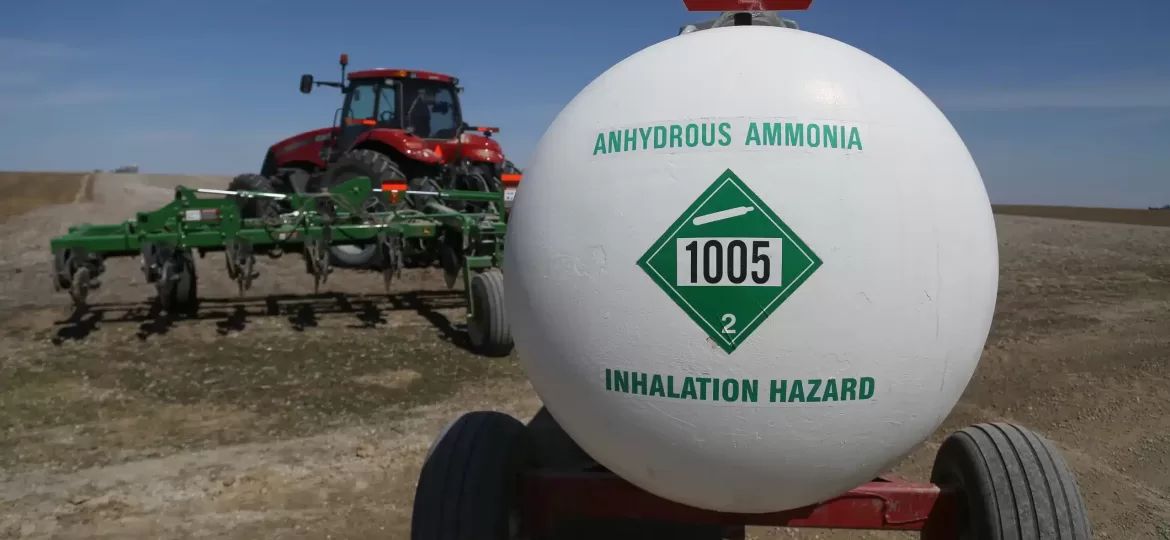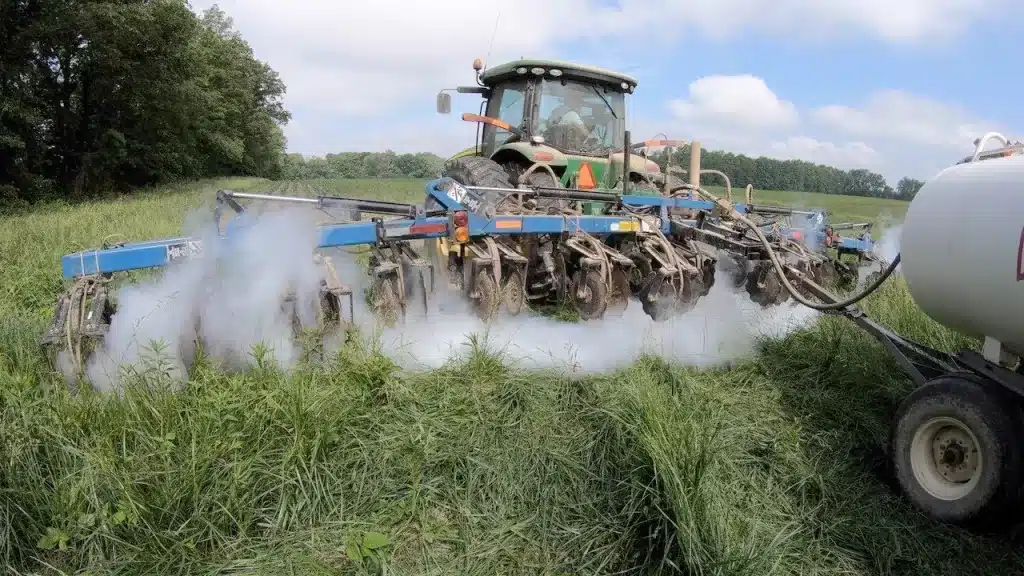
1. Introduction: What Is Anhydrous Ammonia?
Anhydrous ammonia (chemical formula: NH₃) is a colorless, highly pungent gas used extensively in agriculture and industry. The term “anhydrous” means “without water,” emphasizing that the substance contains no moisture. In its pure form, ammonia exists as a gas at room temperature and atmospheric pressure, but it can be compressed into a liquid for easier storage and transport.
It is one of the most essential nitrogen-based compounds in global trade. Over 80% of anhydrous ammonia produced worldwide is utilized as a fertilizer or fertilizer feedstock, directly impacting food production and agricultural efficiency. The remaining portion serves diverse industrial purposes, from refrigeration to the synthesis of chemicals and explosives.
Due to its critical role in multiple sectors and its classification as a hazardous substance, anhydrous ammonia is subject to strict international regulations concerning its storage, handling, and cross-border movement.
In the following sections, we will explore its chemical properties, applications, logistical requirements, and how ATABAŞ GRUP ensures safe and reliable sourcing for international buyers.
2. Applications of Anhydrous Ammonia
Anhydrous ammonia is a versatile compound with widespread applications across key industries. Below are the primary sectors and the specific uses of NH₃:
A. Agricultural Use
| Application | Details |
|---|---|
| Direct Fertilizer | Injected into soil as a nitrogen source, especially for corn, wheat, and cotton. |
| Fertilizer Feedstock | Used in the production of urea, ammonium nitrate, ammonium sulfate, and other nitrogen fertilizers. |
| Crop Yield Enhancer | Supports rapid plant growth and boosts photosynthesis through nitrogen enrichment. |
🌱 Note: One ton of anhydrous ammonia can produce approximately two tons of urea fertilizer.
B. Industrial Refrigeration
| Sector | Use |
|---|---|
| Food Processing | Industrial coolers and freezers (especially in meat/dairy plants). |
| Ice Manufacturing | Ammonia-based systems used due to high thermal efficiency. |
Ammonia is favored in refrigeration for its low environmental impact and excellent heat transfer properties.
C. Chemical Manufacturing
| Derived Products | Examples |
|---|---|
| Nitric Acid | Essential in explosives and plastics manufacturing. |
| Amines & Nitriles | Used in pharmaceuticals, resins, dyes, and fibers. |
| Hydrogen Production | Reforming process in hydrogen plants. |
D. Explosives Industry
Anhydrous ammonia is a key ingredient in the synthesis of ammonium nitrate, which is widely used in mining, quarrying, and civil engineering as a blasting agent. It also appears in certain military-grade energetic materials.

E. Environmental Applications
- Flue Gas Treatment (DeNOx Systems): Reduces nitrogen oxide (NOx) emissions in power plants and industrial boilers.
- Water Treatment: Controls pH levels and neutralizes acidic components.
. Technical Specifications of Anhydrous Ammonia (NH₃)
Understanding the chemical and physical properties of anhydrous ammonia is essential for safe handling, transport, and usage. The following table outlines the critical specifications required for commercial and industrial-grade NH₃:
Technical Data Table
| Property | Typical Value | Description |
|---|---|---|
| Chemical Formula | NH₃ | Composed of one nitrogen atom and three hydrogen atoms. |
| Molecular Weight | 17.03 g/mol | Indicates its light molecular structure. |
| Physical State (at 25°C) | Gas | Compressed into liquid form for storage/transport. |
| Boiling Point | -33.34°C | Vaporizes quickly under atmospheric conditions. |
| Melting Point | -77.7°C | Critical for evaluating cryogenic storage. |
| Density (liquid at -33°C) | 0.6819 g/cm³ | Lower than water, influencing container sizing. |
| Vapor Pressure (at 20°C) | 8.6 bar | Requires pressurized tanks for storage. |
| Purity (Industrial Grade) | ≥ 99.5% | High purity levels required for agricultural and industrial use. |
| Flammability Limits in Air | 15–28% | Must be kept away from ignition sources. |
| Solubility in Water | Highly soluble | Forms ammonium hydroxide; must be handled with caution. |
| Odor | Pungent, sharp smell | Acts as a natural warning due to its strong odor. |
| UN Number (ADR Classification) | UN 1005 | Internationally recognized transport identifier. |
| Hazard Classification | Class 2.3 (Toxic Gas), Class 8 (Corrosive) | Managed under hazardous goods regulations. |
These properties make NH₃ a valuable but hazardous material. Its usage is strictly regulated in global trade to prevent environmental and occupational risks.
4. Storage and Transport Requirements for Anhydrous Ammonia
Because anhydrous ammonia is classified as a toxic, corrosive, and flammable substance, its storage and transportation demand strict regulatory compliance and technical precision. Mishandling may lead to severe human and environmental hazards.
A. Storage Conditions
| Parameter | Requirement |
|---|---|
| Storage Form | Pressurized liquid (under approx. 8.6 bar at 20°C) |
| Storage Tanks | Carbon steel pressure vessels compliant with ASME/EN standards |
| Temperature Monitoring | Continuous monitoring required to prevent vaporization and overpressure |
| Ventilation Systems | Mandatory in storage areas to prevent gas accumulation |
| Tank Placement | Must be in open-air or ventilated shelters, away from populated zones |
| Corrosion Protection | Inner coatings or sacrificial anodes to prevent metal degradation |
| Separation from Incompatibles | Kept away from acids, oxidizers, halogens, and flammable materials |
Note: Even trace moisture in tanks must be avoided to preserve the “anhydrous” nature of the ammonia.
B. Transport Requirements
| Aspect | Details |
|---|---|
| Transport Mode | ISO tank containers, rail tank cars, road tankers (ADR compliant) |
| UN Number | UN 1005 |
| Labeling | Toxic Gas (Class 2.3), Corrosive (Class 8) markings and placards |
| Driver Certification | Required under ADR / DOT regulations for hazardous materials |
| Vehicle Equipment | Emergency shut-off valves, ammonia-rated hoses, PPE for spills |
| Documentation | MSDS (Material Safety Data Sheet), Transport Emergency Cards, Customs Clearance |
| International Compliance | Must adhere to IMDG (maritime), IATA (air), ADR (road), RID (rail) rules |
Emergency Preparedness
All storage and transport units must include:
- Ammonia-resistant protective gear (gloves, suits, goggles)
- Gas detectors and alarm systems
- Eyewash and safety shower stations nearby
- Spill containment kits and neutralizing agents
5. Import and Export Conditions for Anhydrous Ammonia
Global trade of anhydrous ammonia is tightly regulated due to its chemical hazard classification and strategic industrial value. Exporters and importers must navigate customs controls, licensing regimes, and safety protocols to ensure compliance and uninterrupted supply chains.
A. Harmonized System Code (HS / GTIP)
| Classification | Code | Notes |
|---|---|---|
| HS Code (International) | 2814.10 | Anhydrous ammonia, whether or not liquefied |
| GTIP (Turkey) | 2814.10.00.00.11 | Designated for non-aqueous (pure) ammonia |
These codes must be declared accurately in all customs documents to avoid legal or procedural issues.
B. Leading Exporting and Importing Countries
| Top Exporters | Top Importers |
|---|---|
| Russia | United States |
| Trinidad and Tobago | Brazil |
| Saudi Arabia | India |
| Qatar | South Korea |
| United States | European Union (Netherlands, France) |
Export patterns often align with countries having natural gas feedstock, as ammonia production depends on hydrogen sourcing.
C. Licensing and Trade Compliance
| Requirement | Details |
|---|---|
| Export License (Country Dependent) | Many countries require dual-use or hazardous substance export permits |
| End-Use Certification | Required for defense-sensitive or high-volume shipments |
| REACH Registration (EU) | Mandatory for EU imports; registration under chemical regulations |
| Customs Clearance | Pre-shipment inspection, declaration of UN classification, SDS/MSDS |
| Anti-Diversion Controls | Exporters must document the end-user and restrict resale to sanctioned regions |
D. Key Documents for Cross-Border Shipments
- Commercial Invoice
- Packing List
- Material Safety Data Sheet (MSDS)
- Certificate of Analysis (COA)
- Transport Emergency Card (TREM Card)
- UN Dangerous Goods Declaration
- Letter of Credit (if applicable)
The global ammonia trade is also influenced by geopolitical trends, fertilizer demand, and energy prices, which we can explore in a later section if needed.
6. Trade Considerations and Risk Management
Anhydrous ammonia offers high commercial value but requires a strategic and safety-conscious approach to international trade. Stakeholders must manage a range of risks including regulatory compliance, market volatility, and operational hazards.
A. Key Trade Considerations
| Aspect | Details |
|---|---|
| Product Quality Assurance | Buyers demand ≥99.5% purity and strict adherence to agreed specifications. |
| Volume Contracting | Large shipments (e.g., >500 MT) often require long-term offtake agreements. |
| Freight Availability | Limited number of certified ammonia tankers can lead to logistics bottlenecks. |
| Seasonal Demand | Higher in agricultural seasons (pre-sowing periods) – affects pricing. |
| Currency Risk | USD-dominated trade can expose both parties to FX fluctuations. |
B. Safety and Legal Risks
| Risk | Mitigation Strategy |
|---|---|
| Regulatory Violation | Work with licensed clearing agents; verify UN, ADR, REACH, and SDS data. |
| Environmental Incident | Mandatory spill kits, ammonia sensors, and emergency drills. |
| Human Exposure | Equip staff with full PPE; provide hazard training. |
| Contract Disputes | Use ICC-governed contracts or standby letters of credit (SBLCs). |
| Transit Accidents | Insure cargo under marine & general liability with specific ammonia clauses. |
C. Recommended Best Practices for Exporters and Importers
- Conduct due diligence on end-users and logistic providers.
- Ensure COA and MSDS match the actual shipment lot.
- Confirm tank integrity with ultrasonic thickness testing before each loading.
- Never ship to embargoed, sanctioned, or conflict-prone regions without authorization.
- Align internal SOPs with international standards such as ISO 9001 and ISO 14001.
With these trade insights in mind, ATABAŞ GRUP takes a proactive role in delivering compliant, efficient, and secure ammonia logistics to international buyers.
7. ATABAŞ GRUP’s Role in Global Ammonia Trade
ATABAŞ GRUP, a globally trusted name in strategic commodity trading, plays a critical role in the secure and efficient distribution of anhydrous ammonia. Leveraging its extensive logistics infrastructure and regulatory expertise, the company provides turnkey supply solutions that meet the highest international standards.
A. Sourcing and Supply Chain Management
ATABAŞ GRUP maintains long-term partnerships with certified ammonia producers in countries such as Russia, Qatar, and Saudi Arabia. These relationships ensure:
- Reliable access to high-purity (≥99.5%) NH₃
- Flexible FOB and CIF delivery options
- Transparent allocation for seasonal agricultural surges
Each shipment is matched with pre-export quality checks, documentation accuracy, and safety testing before departure.
B. Secure Logistics and Transport Handling
ATABAŞ GRUP operates in major export corridors including:
- Mersin Port (Turkey)
- Port of Hamriyah (UAE)
- Novorossiysk (Russia)
All logistics partners are vetted for compliance with ADR, IMDG, and REACH guidelines. The company utilizes:
- ISO-certified pressure tanks
- Onboard ammonia detection and response systems
- Dedicated emergency response teams during high-volume transport
C. Compliance, Documentation, and Customization
ATABAŞ GRUP provides a complete set of trade documents, tailored for each client’s import country:
- Certificate of Analysis (COA)
- SDS (Safety Data Sheet) in local language
- UN Dangerous Goods Declaration
- Packaging conformity certificates
- REACH dossier or exemption statements (EU clients)
Additionally, the company offers custom contract structuring such as:
- Spot transactions
- Framework agreements
- SBLC-backed trade models
- Governmental tender participation
D. Commitment to Safety and Sustainability
ATABAŞ GRUP ensures that all ammonia-related operations follow both environmental and occupational safety best practices. The company actively promotes:
- Zero-leakage loading protocols
- Eco-compliant ammonia neutralization systems
- Periodic audits and emergency drills

